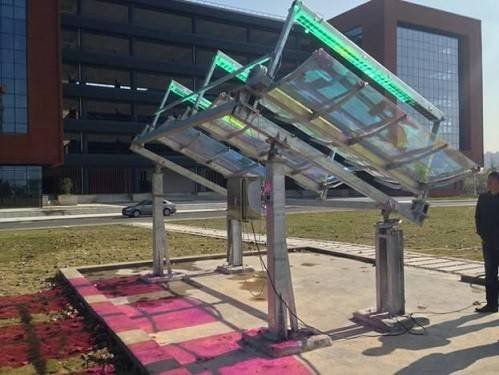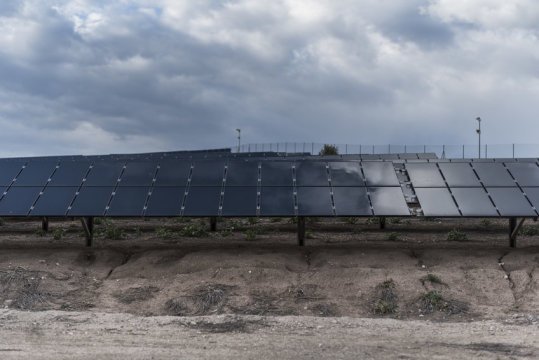
Solar power is becoming more cost effective and energy efficient.
There are a lot of cool new solar power generating devices coming out offering increased power generation or the ability to grow crops below panels. These innovations hold a lot of promise for the future!
It is funny to think about how 'oil-dependent' humanity truly has become when we can just look up and see an abundant source of energy that we have hardly even begun to tap into.
I'm talking about the sun. Everyday it gives us rays of warmth and energy but to this day it makes up just a very small percentage of the overall energy conversion cycle on our planet.
With such a clean and amazing source of energy why hasn't humanity gone completely solar by now? Could it be that true freedom isn't what the powers that be have in mind for humanity?
The good news is that solar energy generation is becoming a lot more efficient and it is being used to generate more power than ever before in 2018.
In this article I will discuss a few interesting developments as it relates to solar power and talk about the potential this new trend could have in making our world a cleaner and more sustainable place to live.
In a recent article titled 'Energy-making gold specks may boost solar storage' the author makes some interesting points about a new material that has the potential to make solar power generation a lot more efficient.
According to the author, a brand new method which involves creating star-shaped gold nanoparticles which are coated with a semiconductor have the ability to produce hydrogen from water at a rate that is over four times more efficient than other methods.
You see, it isn't just about generating the energy, it is about finding an effective way to store the energy and this new method leads to a significantly better way to store solar energy, according to a new study.


Image Source: Futurity

This new development has the potential to boost renewable energy use and fight climate change, according to prominent researchers in the field.
“Instead of using ultraviolet light, which is the standard practice, we leveraged the energy of visible and infrared light to excite electrons in gold nanoparticles,” says Laura Fabris, associate professor in the materials science and engineering department at Rutgers University.
“Excited electrons in the metal can be transferred more efficiently into the semiconductor, which catalyzes the reaction.”
That is a lot of scientific talk which amounts to this new method being simply a better way to collect solar energy.
“Our outstanding results were ever so clear,” Fabris says. “We were also able to use very low temperature synthesis to coat these gold particles with crystalline titanium. I think both from the materials perspective and the catalysis perspective, this work was very exciting all along."
“This was our first foray,” she says, “but once we understand the material and how it operates, we can design materials for applications in different fields, such as semiconductors, the solar or chemical industries, or converting carbon dioxide into something we can use. In the future, we could greatly broaden the ways we take advantage of sunlight.”
This possibility really excites me. If you look at this new technology as simply a building block in creating something even greater then the opportunities for expanding on this new found method are incredible!
Think about the problem of global warming which is so frequently brought up as a topic of conversation. Can you imagine if we were able to conver carbon dioxide into something which was of use to us greatly reducing what is believed to be the biggest factor in global warming (excessive carbon dioxide in the atmostphere).


Image Source: LaserFocusWorld

Now let me turn your attention to another solar power generation method which may become incredibly popular amongst farmers.
There is a new type of concentrating solar panel that harvests solar energy while also letting red and blue light go through to illuminate crops growing underneath, without sacrificing growth performance.
This is an incredible new method in my opinion as it means that farmers could find a way to generate increased revenues while also contributing to a more sustainable environment!
A recent report published by Laser Focus World outlines and clearly explains the potential this new technology may have for transforming the entire industry.
"If you look at the solar panels that are typically installed on farmland areas, you can't do much beneath them so farmers have basically had to give up part of their land for this solar panel insulation," Ingenhoff, in an interview with R&D Magazine, said. "Some farmers are OK with it because they have very large land areas, but in countries like Israel or China, where you have a shortage of land, it is not good to sacrifice that land for regular solar panels."
According to the article the team currently has four working prototypes installed in China. If you are unfamiliar with China's problems regarding recent urban development, it is a country with an urgent need to maintain and recover any agricultural land it can because of the insane over-urbanization the country has undergone in the past few decades.


Image Source: Science Daily

In another recent article published by Science Daily, it highlights how researchers have found a cheap, sustainable way to build a solar cell using bacteria that convert light to energy.
Apparently, their cell generated a current stronger than any previously recorded from such a device. Beyond that it also produced some very strange but promising results as it worked as efficiently in dim light as in bright light.
Researchers also proposed that this innovation could be a step toward wider adoption of solar power in places like British Columbia and parts of northern Europe where overcast skies are common.
The fact of the matter is that there are some incredible new technologies being developed related to solar power generation. If we can really get humanity behind moving over to a more sustainable way of life there may be hope for us yet!
Do you see solar power being used a lot more in our lifetimes? What do you think is the biggest factor keeping us from completely moving over to sustainable energy as a species?
Thanks for reading.
Authored by: @techblogger
In-text citations sources:
Energy-making gold specks may boost solar storage - Futurity
New solar panels harvest energy and also allow crops to grow underneath - LaserFocusWorld
Bacteria-powered solar cell converts light to energy, even under overcast skies - ScienceDaily
Image Source:
Futurity
LaserFocusWorld
excellent post
Downvoting a post can decrease pending rewards and make it less visible. Common reasons:
Submit
We have to look at the solar power and nuclear power right now before the shortage of fossil fuel began to bother us.
Downvoting a post can decrease pending rewards and make it less visible. Common reasons:
Submit
What an amazing news. A good alternative to a power problem. It will be the future of the world. Thanks for sharing.
Downvoting a post can decrease pending rewards and make it less visible. Common reasons:
Submit
@techblogger solar power will surely be common in upcoming few years.
Downvoting a post can decrease pending rewards and make it less visible. Common reasons:
Submit
The mass deployment of solar energy will be largely dependent on how cheaply it can be stored (this is why fossil fuels are hard to transition away from; they represent highly concentrated sources of stored solar energy in chemical form).
Electricity is expensive to store, but I hear that solar thermochemical fuels can also be manufactured, thereby created a liquid fuel source...
Downvoting a post can decrease pending rewards and make it less visible. Common reasons:
Submit
To add on to this, Stanford did do a study on sodium based batteries, which can be manufactured much more cheaply than Li-Ion batteries.
Downvoting a post can decrease pending rewards and make it less visible. Common reasons:
Submit